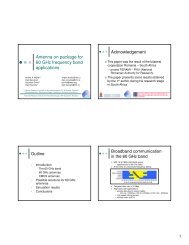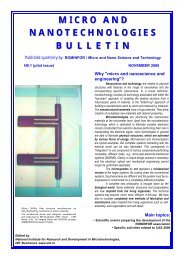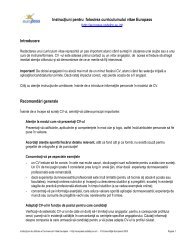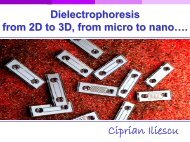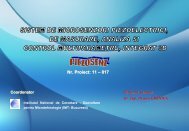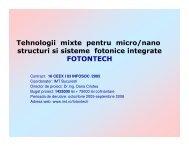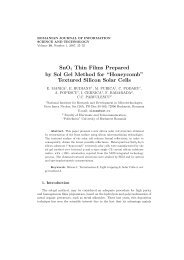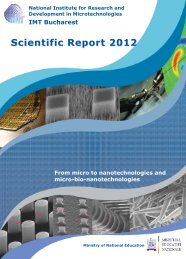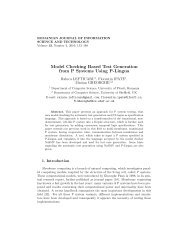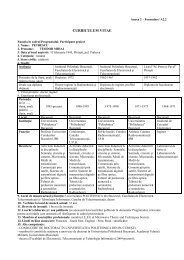Wide Tuning Range Active RF Bandpass Filter with MOS ... - IMT
Wide Tuning Range Active RF Bandpass Filter with MOS ... - IMT
Wide Tuning Range Active RF Bandpass Filter with MOS ... - IMT
Create successful ePaper yourself
Turn your PDF publications into a flip-book with our unique Google optimized e-Paper software.
490 C. Andriesei et al.ε ox S/t ox , <strong>with</strong> S the transistor channel area and t ox the oxide thickness but also thehighest possible Q value, C<strong>MOS</strong> varactors work in accumulation and strong inversion.The biasing region is important when talking about power consumption. Thus,regarding the VCO design, those which use varactors working in accumulation modeare characterized by a lower power consumption and phase noise compared to thosebased on strong inversion.Fig. 5. Differential dc decoupled negative resistance.Regarding the tuning range, varactors working in accumulation have very largeC max to C min ratio compared to other structures.For our proposed circuit, since all varactors are connected to the node correspondingto the parasitic capacitor of the inductor, the value of the inductor is kept constantwhile the self resonance frequency is changed. After the change of the varactor value,a corresponding change of the negative resistance is required in order to obtain therequired quality factor value but <strong>with</strong> no effect on the resonance frequency.The capacitance values needed in the above application are much smaller (fF)compared to the VCO case (pF). Moreover, in the filter case, since the signal valuesare small, the capacitance remains unchanged compared to the case of VCO wherethe instantaneous capacitance value changes during the signal period.3. Simulation resultsThe active bandpass filter shown in Fig. 4 was designed in a 0.18 µm C<strong>MOS</strong> processfor a center frequency of 2.4 GHz which is also the maximum frequency achievableby this method <strong>with</strong> a power consumption of 1 mW. Higher frequency values are stillpossible but <strong>with</strong> an extra power consumption for the active inductor.The possibility of implementing an independent frequency and quality factor tuningis shown in Fig. 6. The center frequency is 2.4 GHz and is constant while thequality factor changes from 6 to 2000 <strong>with</strong> no problems of instability even for the
<strong>Wide</strong> <strong>Tuning</strong> <strong>Range</strong> <strong>Active</strong> <strong>RF</strong> <strong>Bandpass</strong> <strong>Filter</strong> <strong>with</strong> <strong>MOS</strong> Varactors 491highest quality factor value. However, further change of the negative resistance valuewill cause instability, as reflected by the transient responses, shown in Fig. 6.Fig. 6. Quality factor tuning, f 0 = 2.42 GHz and transient response showingpotential instability.As the frequency and transient responses show, the quality factor change influencesthe amplitude only. This is not the case for other achievable bands where by using
492 C. Andriesei et al.varactors the center frequency as well as the transient response change. It has beenobserved that for the designed circuit a current higher than 240 µA passing throughM 1 and M 2 which simulate the negative resistance leads to instability.Fig. 7. Frequency and time behavior for 1.8 GHz and 1.9 GHz GSM bandsusing varactors.As mentioned above, the center frequency is changed by using varactors and thenthe quality factor is tuned. By using the first varactor T 1 (3.5/1), the center frequency
<strong>Wide</strong> <strong>Tuning</strong> <strong>Range</strong> <strong>Active</strong> <strong>RF</strong> <strong>Bandpass</strong> <strong>Filter</strong> <strong>with</strong> <strong>MOS</strong> Varactors 493can be decreased to the 1800 and 1900 MHz (GSM bands), the frequency tuning beingpossible in the frequency range 1.77–1.99 GHz. The filter behavior in this band isshown in Fig. 7 together <strong>with</strong> a transient response.It can be seen that for all four frequencies, the filter is stable.By using the second varactor T 2 (6.5/6), the center frequency is further decreasedin order to work in the lower GSM band, the frequency tuning being possible in thefrequency range 600–990 MHz through a suitable change in V tune . The frequencyresponse for this GSM band is illustrated in Fig. 8.Fig. 8. Frequency behavior for the 600–990 GHz GSM band.4. ConclusionA new wide frequency range tuning possibility was studied for a particular configurationof active all–N<strong>MOS</strong> <strong>RF</strong> bandpass filter. The tuning principle makes useof negative resistances aiming for an independent frequency and quality factor tuning.To achieve wide frequency tuning range only 2 varactors are used in order tocover the GSM bands <strong>with</strong> no extra power. A third possible varactor can be used inorder to cover the UMTS frequencies as well. A maximum frequency of 2.4 GHz isachieved <strong>with</strong> this principle <strong>with</strong> small power consumption and very high quality factor(up to 2000) can be achieved <strong>with</strong>out instability problems. The maximum powerconsumption is 1 mW for a 1.8 V supply being independent of the center frequency.
494 C. Andriesei et al.References[1] HE X., KUHN W., A 2.5-GHz Low-Power, High Dynamic <strong>Range</strong>, Self-Tuned Q-Enhanced LC <strong>Filter</strong> in SOI, IEEE Journal of Solid–State Circuits, vol. 40, no. 8,pp. 1618–1628, August 2005.[2] GEORGESCU B., PEKAU H., HASLETT J., MCRORY J., Tunable Coupled InductorQ-enhancement for Parallel Resonant LC Tanks, IEEE Trans. on Circuits and Systems,vol. 50, no. 10, pp. 705–713, October 2003.[3] KUHN W., NOBBOE D., KELLY D., OSBORN A., Dynamic <strong>Range</strong> Performance ofOn-Chip <strong>RF</strong> <strong>Bandpass</strong> <strong>Filter</strong>s, IEEE Trans. on Circuits and Systems, vol. 50, no. 10,pp. 685–694, October 2003.[4] LI D., TSIVIDIS Y., Design Techniques for Automatically Tuned Integrated Gigahertz-<strong>Range</strong> <strong>Active</strong> LC FIlters, IEEE Journal of Solid–State Circuits, vol. 37, no. 8, pp. 967–977, August 2002.[5] TSENG S.-H., HUNG Y.-J., JUANG Y.-Z., LU M. S.-C., A 5.8-GHz VCO <strong>with</strong> C<strong>MOS</strong>–compatible MEMS inductors, Sensors and Actuators A: Physical, Vol. 139, pp. 187–193,2007.[6] ELZAYAT A., DEGBE M., DOMINGUE F., NERGUIZIAN V., A Suspended MEMSinductor of a new geometry and a novel anchor for <strong>RF</strong> applications, IEEE InternationalSymposium on Industrial Electronics, Vol. 4, pp. 3332–3337, 2006.[7] PARK E.-C., CHOI Y.-S., YOON J.-B., HONG S., YOON E., Fully Integrated LowPhase–Noise VCOs With On–Chip MEMS Inductors, IEEE Transaction on MicrowaveTheory and Technoques, Vol. 51, No. 1, 2003.[8] YOON J.-B., CHOI Y.-S., KIM B.-I., EO Y., YOON E., C<strong>MOS</strong>-compatible, surface micromachined,suspended spiral inductors for multi-GHz silicon <strong>RF</strong> ICs, Electron DeviceLett., Vol. 23, pp. 591–593, Oct. 2002.[9] CHUA C.L., FORK D.K., VAN SCHUYLENBERGH K., LU J.-P., Out-of-plane high-Q inductors on low-resistance silicon, Journal of Microelectromechanical Systems, Vol.12, No. 6, pp. 989–995, 2003.[10] www.triquint.com[11] www.epcos.com[12] HARA S., TOKUMITSU T., Broad-Band Monolithic Microwave <strong>Active</strong> Inductor andIts Application to Miniaturized <strong>Wide</strong>-Band Amplifiers, IEEE MTT, 1988, Vol. 36, No.12.[13] THANACHAYANONT A., PAYNE A., VHF C<strong>MOS</strong> integrated active inductor, ElectronicsLetters, Vol. 32, No. 11, May 1996.[14] WU Y., ISMAIL M., A Novel C<strong>MOS</strong> Fully Differential Inductorless <strong>RF</strong> <strong>Bandpass</strong> <strong>Filter</strong>,Proc. IEEE ISCAS, pp. 149–152, Vol. 4, 2000.[15] KARŞILAYAN A., SCHAUMANN R., A High–Frequency High–Q C<strong>MOS</strong> <strong>Active</strong> Inductor<strong>with</strong> DC Bias Control, Proc. 43 rd IEEE Midwest Symposium on Circuits andSystems, pp. 486–489, Vol. 1, August 2000.[16] THANACHAYANONT A., NGOW S., Low Voltage High-Q VHF C<strong>MOS</strong> Transistor-Only <strong>Active</strong> Inductor, The 2002 45 th Midwest Symposium on Circuits and Systems,MWSCAS–2002, vol. 3, pp. III-552–III-555, Thailand.
<strong>Wide</strong> <strong>Tuning</strong> <strong>Range</strong> <strong>Active</strong> <strong>RF</strong> <strong>Bandpass</strong> <strong>Filter</strong> <strong>with</strong> <strong>MOS</strong> Varactors 495[17] LIANG K., HO C., C<strong>MOS</strong> <strong>RF</strong> Band-Pass <strong>Filter</strong> Design Using the High Quality <strong>Active</strong>Inductor, IEICE Trans. Electron., Vol. E-88-C, No. 12, 2005.[18] ALLIDIMA K., MIRABBASI S., A <strong>Wide</strong>ly Tunable <strong>Active</strong> <strong>RF</strong> <strong>Filter</strong> Topology, IEEEInternational Symposium on Circuits and Systems, ISCAS 2006 Proceedings, pp. 879–882, May 2006, Greece.[19] GAO Z., MA J.-G., A C<strong>MOS</strong> <strong>Bandpass</strong> <strong>Filter</strong> <strong>with</strong> <strong>Wide</strong>-<strong>Tuning</strong> <strong>Range</strong> for WirelessApplications, IEEE International Symposium on Circuits and Systems, ISCAS 2006Proceedings, pp. 867–870, May 2006, Greece.[20] THANACHAYANONT A., 2-V 3.36-mW 2.5 GHz Fourth-Order Inductorless C<strong>MOS</strong><strong>RF</strong> <strong>Bandpass</strong> <strong>Filter</strong>, The Asia–Pacific Conference on Circuits and Systems, APCCAS–2002, Vol. 1, pp. 127–130, Thailand.[21] WU Y., ISMAIL M., <strong>RF</strong> <strong>Bandpass</strong> <strong>Filter</strong> Design Based on C<strong>MOS</strong> <strong>Active</strong> Inductors,IEEE Transactions on Circuits and Systems, vol. 50, no. 12, pp. 942–949, December2003.[22] DINH A., GE J., A Q-Enhanced 3.6 GHz, Tunable, Sixth-Order <strong>Bandpass</strong> <strong>Filter</strong> Using0.18 µm C<strong>MOS</strong>, VLSI Design, Volume 2007, Article ID 84650, 2007.[23] ANDRIESEI C., GORAS L., On the <strong>Tuning</strong> Possibilities of an <strong>RF</strong> <strong>Bandpass</strong> <strong>Filter</strong><strong>with</strong> Simulated Inductor, International Semiconductor Conference-CAS 2007, vol. 2,pp. 489–492, October 2007, Romania.[24] ANDRIESEI C., GORAS L., TEMCAMANI F., Negative Resistance Based <strong>Tuning</strong>of an <strong>RF</strong> <strong>Bandpass</strong> <strong>Filter</strong>, Fourth European Conference on Circuits and Systems forCommunications, ECCSC 2008, vol. 1, pp. 1–4, July 2008, Romania.



